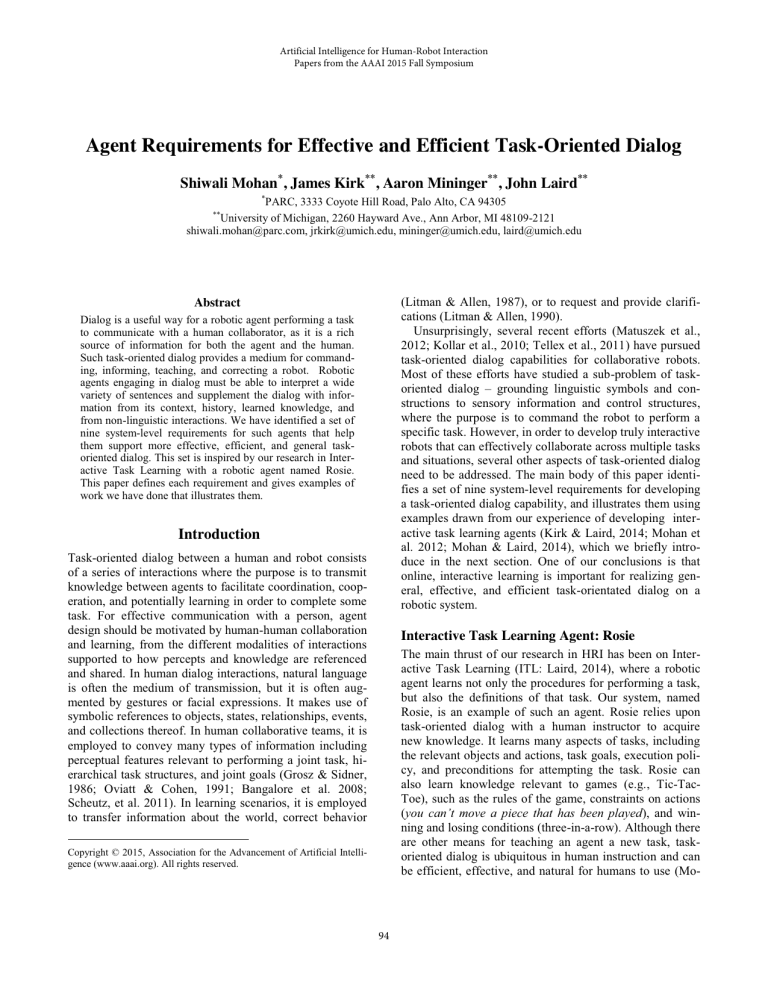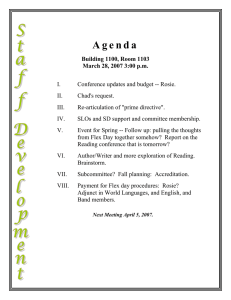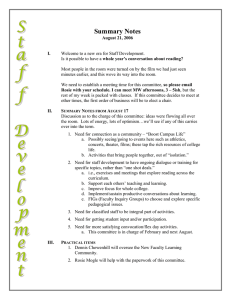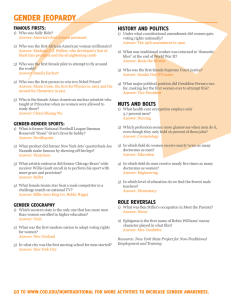
Artificial Intelligence for Human-Robot Interaction
Papers from the AAAI 2015 Fall Symposium
Agent Requirements for Effective and Efficient Task-Oriented Dialog
Shiwali Mohan*, James Kirk**, Aaron Mininger**, John Laird**
*
PARC, 3333 Coyote Hill Road, Palo Alto, CA 94305
University of Michigan, 2260 Hayward Ave., Ann Arbor, MI 48109-2121
shiwali.mohan@parc.com, jrkirk@umich.edu, mininger@umich.edu, laird@umich.edu
**
(Litman & Allen, 1987), or to request and provide clarifications (Litman & Allen, 1990).
Unsurprisingly, several recent efforts (Matuszek et al.,
2012; Kollar et al., 2010; Tellex et al., 2011) have pursued
task-oriented dialog capabilities for collaborative robots.
Most of these efforts have studied a sub-problem of taskoriented dialog – grounding linguistic symbols and constructions to sensory information and control structures,
where the purpose is to command the robot to perform a
specific task. However, in order to develop truly interactive
robots that can effectively collaborate across multiple tasks
and situations, several other aspects of task-oriented dialog
need to be addressed. The main body of this paper identifies a set of nine system-level requirements for developing
a task-oriented dialog capability, and illustrates them using
examples drawn from our experience of developing interactive task learning agents (Kirk & Laird, 2014; Mohan et
al. 2012; Mohan & Laird, 2014), which we briefly introduce in the next section. One of our conclusions is that
online, interactive learning is important for realizing general, effective, and efficient task-orientated dialog on a
robotic system.
Abstract
Dialog is a useful way for a robotic agent performing a task
to communicate with a human collaborator, as it is a rich
source of information for both the agent and the human.
Such task-oriented dialog provides a medium for commanding, informing, teaching, and correcting a robot. Robotic
agents engaging in dialog must be able to interpret a wide
variety of sentences and supplement the dialog with information from its context, history, learned knowledge, and
from non-linguistic interactions. We have identified a set of
nine system-level requirements for such agents that help
them support more effective, efficient, and general taskoriented dialog. This set is inspired by our research in Interactive Task Learning with a robotic agent named Rosie.
This paper defines each requirement and gives examples of
work we have done that illustrates them.
Introduction
Task-oriented dialog between a human and robot consists
of a series of interactions where the purpose is to transmit
knowledge between agents to facilitate coordination, cooperation, and potentially learning in order to complete some
task. For effective communication with a person, agent
design should be motivated by human-human collaboration
and learning, from the different modalities of interactions
supported to how percepts and knowledge are referenced
and shared. In human dialog interactions, natural language
is often the medium of transmission, but it is often augmented by gestures or facial expressions. It makes use of
symbolic references to objects, states, relationships, events,
and collections thereof. In human collaborative teams, it is
employed to convey many types of information including
perceptual features relevant to performing a joint task, hierarchical task structures, and joint goals (Grosz & Sidner,
1986; Oviatt & Cohen, 1991; Bangalore et al. 2008;
Scheutz, et al. 2011). In learning scenarios, it is employed
to transfer information about the world, correct behavior
Interactive Task Learning Agent: Rosie
The main thrust of our research in HRI has been on Interactive Task Learning (ITL: Laird, 2014), where a robotic
agent learns not only the procedures for performing a task,
but also the definitions of that task. Our system, named
Rosie, is an example of such an agent. Rosie relies upon
task-oriented dialog with a human instructor to acquire
new knowledge. It learns many aspects of tasks, including
the relevant objects and actions, task goals, execution policy, and preconditions for attempting the task. Rosie can
also learn knowledge relevant to games (e.g., Tic-TacToe), such as the rules of the game, constraints on actions
(you can’t move a piece that has been played), and winning and losing conditions (three-in-a-row). Although there
are other means for teaching an agent a new task, taskoriented dialog is ubiquitous in human instruction and can
be efficient, effective, and natural for humans to use (Mo-
Copyright © 2015, Association for the Advancement of Artificial Intelligence (www.aaai.org). All rights reserved.
94
han 2015). Rosie is implemented in Soar (Laird, 2012) and
is embodied in a table-top robot. It also has recently been
ported to a mobile robot where we are teaching it delivery,
patrolling, and similar tasks.
similar groundings for the other concepts in order to maintain a uniform representation of the various types of
knowledge that connect observations of the environment,
references in the dialogue interaction, and previously
learned knowledge.
Agent Requirements for Task-Oriented Dialog
Encode typical information-exchange protocols
In task-oriented dialog, prototypical types of utterances are
employed for exchanging different types of information.
Imperative sentences, such as put that book in the shelf, are
used to covey an intended goal to be achieved by the listener. Assertions such as there is a blue couch in the living
room are used to convey a belief about the environment. A
question (where is the milk?) can be employed to supplement perceptual information by relying on the collaborative partner’s knowledge of the environment. In order to
correctly interpret or generate these utterances, the agent
must understand how the structure of an utterance relates
to the information that is being provided or requested.
Rosie has a simple referential grammar (implemented as
rules) to generate reasonable responses to the instructor’s
utterances. This grammar assumes nouns (block) and adjectives (red) refer to visual properties of objects sensed
through the camera; referring expressions (the red large
block) refer to specific objects in the environment; prepositions (behind) refer to spatial relationships between objects; and verbs (place) refer to abstract task descriptions.
Imperative sentences composed of these elements (place
the red large block behind the small yellow triangle) refer
to a task representation instantiated with relevant objects,
relationships, and a goal. Comprehension of these imperatives results in Rosie executing the instantiated task in the
environment. Rosie also understands and generates questions (what kind of attribute is purple?) and statements (the
red block is behind the yellow triangle).
The implemented grammar is small and is designed with
a perspective that Rosie functions in the ITL domain where
its primary goal is to learn new tasks. While the grammar
has been useful in teaching Rosie a variety of tasks, it is
hand-engineered. An ideal learner should expand its
knowledge of information-exchange protocols as it gathers
interactive experience. Currently, Rosie can learn to
ground new words to components of its environment and
new verbs to actions, but it cannot learn new types of utterances and how they connect to its behavior and goals.
Based on our experience with ITL and more specifically
our implementation of Rosie, we have identified a set of
requirements for supporting task-oriented dialog, driven by
the following criteria:
x Generality: the agent supports many forms of dialog and
modalities of interaction for different types of knowledge
across multiple domains and tasks.
x Efficiency: the number of interactions and the length of
the communications (number of words or gestures) required to transmit a concept is minimized.
x Effectiveness: the agent uses the transmitted information
to direct its behavior and learn about its environment as
well as produce useful information in its communications.
Encode a common reference scheme
Task-oriented dialog contains references to relevant aspects of the environment and the task. For effective communication, collaborators must have a common reference
scheme that specifies how these references will be made.
The agent must know how such references relate to what it
can perceive on its sensors and what it knows about its
environment. This knowledge may be pre-programmed or
learned through experience. This is the grounding problem
which has been widely studied in the prior work.
For Rosie, the instructor can identify objects using different references, including linguistic descriptions (the red
object), gestures (indicating an object and using the word
this), and spatial constraints (the block on the blue rectangle). In all cases, the reference is resolved to an internal
symbolic representation of the object. Symbols referring to
visual properties are also grounded in subsymbolic information. For example, red corresponds to a region of a feature space in a perceptual classifier. Spatial relations are
grounded in comparisons of metric information about the
objects (spatial comparisons of bounding boxes). Through
mappings like these, Rosie grounds words and phrases to
objects in the environment.
These mappings can be preprogrammed, but Rosie also
learns concepts in order to handle novel environments and
tasks. Rosie learns new nouns and adjectives, such as
label names (kitchen, pantry), colors (red, blue), shapes
(rectangle, triangle), and sizes (large, small), and prepositions (on, left of). Regardless of how each concept is
taught, or through which modality of interaction, Rosie
constructs a symbolic representation (red1) of the concept
that connects to related symbolic knowledge (type: color),
subsymbolic knowledge (RGB categorization space), and
the linguistic term used in the dialog (“red”). Rosie learns
Incorporate non-linguistic context for interpretation
Situated dialog between humans is efficient – information
that is apparent from the current environment or is a component of shared beliefs does not have to be explicitly
identified or transmitted by the speaker. This may sometimes lead to ambiguity in the utterances employed by the
speaker. The agent must use its knowledge and experience
95
puzzles. This additional modality of interaction allows for
more flexible and efficient dialog.
of the environment to effectively interpret the dialog within
the current context.
In Rosie, non-linguistic context is used for object reference disambiguation. A simple form is when human instructions use the referent this, accompanied by a gesture
involving clicking on a simulated view of the object. For
references such as it, Rosie uses the sentence structure as
well as the event and dialogue history as context to determine the referred object. In other cases, Rosie uses the context of the current spatial scene to decide between ambiguous preposition attachments, incomplete referring expressions, and polysemous verbs. For example, “move the red
block on the stove” in interpreted differently if the red
block is already on the stove than if it is somewhere else.
Additional context about the current purpose of the interaction can aid interpretation, particularly for sentence
fragments. For example, when Rosie encounters an unknown concept, red, it asks what type of attribute is red?
The response a color can be understood in context of the
question as equivalent to the fuller response red is a color.
Figure 1: Number of words needed to teach four games
through instruction using goal descriptions and
demonstrations.
Incorporate information from multiple interaction modalities
Natural language is not always the most efficient way to
communicate knowledge to the agent. Human dialog is
often augmented with gestures, facial expressions, demonstrations, or sketches. Such interactions can be more efficient and effective at conveying knowledge than language
in many cases. If there are many similar objects in sight, it
can be more efficient to point to one than to try and
uniquely identify it through language. When trying to teach
the agent how to do a new task, it can be more efficient to
demonstrate the task being done than to describe it. In
some cases, it can be more efficient to sketch a desired
configuration of objects than to describe it spatially. Thus,
there are additional modalities of interaction that the agent
should be able to interpret. The agent should integrate information from these interactions with the dialog context.
Rosie cannot interpret visual gestures, but it can interpret the teacher selecting an object on the computer interface and referring to it using the word ‘this’ (e.g., This object is red). As mentioned above, this information is used
to resolve the reference. Rosie cannot interpret sketches or
demonstrations of actions or tasks, but can extract information about goal states from demonstrations. For tasks,
after the instructor has led the agent through the steps of
the tasks, Rosie can infer what the goal of the task is by
identifying what the steps accomplished. For games, Rosie
can extract a representation of the goal from a demonstration of the goal state instead of a natural language description (e.g., in Tower of Hanoi, it is easier to show the final
configuration than to describe it). Figure 1 shows that incorporating goal demonstrations reduces the total number
of words needed to completely teach various games and
Apply reasoning strategies to interaction
Task-oriented dialog is mixed-initiative, flexible, and collaborative. The onus of communication or information
exchange is distributed amongst the participants. Participants advance the dialog in accordance with their intentions and goals and comply with each other's requests. An
example of expert-novice dialog from Grosz and Sidner
(1986) is shown below.
! " # " $ # %+" "/ < ! " In this example, the expert takes the initiative in thinking
about the goals of the joint task and proposes a strategy to
execute it. Although the novice does not know the structure
of the task, she plays an active role in the conversation.
She reasons about her environment and knowledge, identifies issues that impede task execution, and guides the interaction to elicit that information from the expert. This frees
up the expert from having to closely observe and model the
novice in order to provide relevant information.
Often in human controlled interactive learning, such as
learning by demonstration, the onus of learning is completely on the human user. The human has to provide good
demonstration traces that will result in learning at appropriate levels on generality. However, Rosie is designed to
be active and plays a useful role in knowledge acquisition.
96
Whenever it is unable to make progress on the task, either
because it does not understand the words in the instruction,
it does not know the task goals, or it does not know which
action to take next, it changes the state of interaction by
asking a relevant question. Further, it does not completely
rely on the human instructor to provide complete instruction, but instead uses its knowledge of the domain to explore possible task executions. For example, once given the
goal of a task, Rosie attempts to generate a plan through an
internal search of the action space using its internal models
of the primitive actions. It asks for help only if the solution
is beyond its search-depth horizon. Thus, the human instructor can rely on Rosie avoid asking questions that have
obvious answers and to guide interaction to where it needs
to make progress on the task.
Figure 2 shows how the number of interactions with the
instructor (left y axis) decreases (from left to right) as the
agent relies more on its own internal planning when learning how to execute a task. However, this comes at the cost
of exponential increases in processing time (as measured in
decision cycles).
actions it supports and increase the efficiency of communication.
In Rosie, there are multiple ways in which the agent
integrates prior knowledge and takes advantage of hierarchical teaching strategies. Rather than teaching a complex
action, such as cook, by using only primitive actions (pick
up, put down, ...), the task can be decomposed into intermediate actions that are easier to teach, such place. In the
future, these actions can be used by name to teach more
complex actions, such as serve, which uses both cook and
place (Mohan & Laird, 2014). Beyond increasing the efficiency of subsequent commands, it provides a higher level
of abstraction, which is more accessible for the teacher.
Any concept that is taught, including visual properties,
spatial relations, procedural actions, and even specific
goals and actions for games, can be used in subsequent
interactions by name, which for now we assume is unique.
Therefore, Rosie transfers knowledge between games with
similar actions and goals, such as Tic-Tac-Toe and Three
Men’s Morris, which both have the goal of Three-in-a-row.
Figure 3 shows the number of interactions that are used to
teach three games, separately and sequentially (left to right
Connect 3 followed by Tic-Tac-Toe and 4 Queens). In sequential teaching, the agent demonstrates the benefit in
efficiency from the transfer of knowledge between games.
The definitions of these games share not only goals and
actions, but also spatial relations, actions, and visual properties (Kirk & Laird, 2014), so that the number of interactions required to teach Tic-Tac-Toe after learning Connect
3 is significantly less than when teaching Tic-Tac-Toe from
scratch because of the transfer of concept learned in Connect 3. There is a similar result for 4 Queens, but it is not
as dramatic because 4 Queens does not share as many concepts with the other two tasks.
Figure 2: Integrating information communicated through taskoriented dialog with agent planning for efficient interaction.
Integrate prior knowledge
During long-lived human robot interactions, a robot will be
commanded to do different tasks, possibly in multiple environments. Interacting with the robot to make it perform
these tasks may involve giving it a sequence of actions to
perform or a set of conditions to achieve or attend to. An
agent that does not learn from these interactions will require these commands to be repeated when given the same
or similar task. In human conversations, references are
often made to previous interactions, using a label that refers to an abstraction over multiple concepts. Humans often structure teaching interactions to hierarchically build
up these structures in order to facilitate accessibility (teaching everything at the most primitive level is tedious) and
transference of knowledge (each concept in a hierarchy can
potentially transfer). This is a fundamental capability necessary for the agent to be able to extend the types of inter-
Figure 3: Transfer of knowledge of concepts evaluated by
number of interactions needed to describe games separately and
sequentially (left to right).
Recent work has extended this capability to include
teaching abstractions for any collection of state features,
97
such that custom features for an environment or task, such
as a protected location for a specific board game, can be
learned and is available for teaching subsequent concepts.
and intentions and explain why it believes its current actions will lead to the goal.
We have taken some small steps towards meeting this
requirement. When teaching Rosie visual properties and
spatial relations, the instructor can ask the agent questions
to judge what it has learned. Some examples include What
is this?, What is in the pantry?, Is the red block on the table?, and What color is this? Rosie currently cannot communicate any knowledge about tasks or games (e.g., describe a valid move in Tic-Tac-Toe or describe the goal of
storing a block), and cannot answer questions about its
own goals. Currently the latter is not very useful because
Rosie only performs actions in response to the instructor’s
commands. One benefit of our system is that most of the
agent’s knowledge and goals are encoded as declarative
representations in either working memory or semantic
memory, making them easily accessible to the agent. For
efficiency, Rosie dynamically compiles its interpretation of
declarative knowledge into rules, so that in many cases it
has a fast procedural representation of knowledge in addition to an accessible declarative representation.
Implement a model of a collaborator’s knowledge, intentions, and goals
When working together on a task, interactions between
collaborators are goal-oriented. Participants communicate
with each other in pursuit of goals, which may pertain to
manipulating and navigating their environments, changing
each other’s belief states, gathering information about the
task and environment, or comprehending what is being
said. A key component of reasoning about interactions is
knowing what the collaborator perceives or knows about
the task and the environment, what their goals are, and
what they intend with their communication. This is useful
in generating the right responses to utterances. In a teaching scenario, the intention behind the question where is
Golden Gate Park? is to test the learner’s knowledge. San
Francisco may be considered a correct answer here. However, in a navigation scenario the same question may be
asked to get to a more precise location or to get directions.
Rosie does not explicitly model or reason about the intent and goals of its instructor. Some of this knowledge is
implicitly encoded in rules that support the information
exchange protocol. Questions from the instructor are always assumed to be tests of knowledge, imperative sentences as action commands that should be executed in the
environment. Similarly, Rosie assumes that on asking
questions, an informative response will be provided. These
assumptions have been useful in the ITL domain; however,
they will not apply when there are several instructors who
have different goals or when the instructor does not know
the task as well. As we extend Rosie to not only function
as a learner but to also participate in collaborative task execution or teach another agent tasks, it will need to explicitly model and reason about its collaborators’ state.
Support informative failure states
Human interactions do not always go smoothly, with
communications often being ambiguous or incomplete.
However, humans can reason about comprehension failures and direct the ongoing interaction with their collaborators to address those failures. They ask for repetitions, clarifications, or explanations. Such behavior requires that the
agent maintain information about why a failure occurred
and what information is required to address that failure.
Rosie has some capability for handling failures. Its parsing is robust to minor ungrammatical lapses, and when it is
unable to parse or semantically interpret a sentence, it will
ask for a rephrasing. When novel words are used in a
command, including new adjectives, prepositions, or verbs,
it will ask for definitions, and reparse the original sentence
with what it has learned. This allows the human to give
commands without knowing precisely what concepts Rosie
already knows.
Communicate the agent’s knowledge, intentions, and
goals
For a human to effectively collaborate with a robotic agent,
it is important that the human can build up a model of the
internal state of the agent. When communicating
knowledge to the agent, it is useful to judge how effective
the interaction has been and how much the agent has
learned. This allows the human to tailor their interactions
to better fit the capabilities of the agent. The human may
correct incorrect knowledge or choose to communicate it in
a different way. Thus the agent must be able to describe its
own knowledge to the human. If the agent also has significant autonomy, the human may wish to know the current
goals and intentions of the agent to better understand what
the agent is currently doing and what it is trying to achieve.
Thus the agent must be able to describe its current goals
Conclusion
Although the implementation of Rosie is only a single case
study, the analysis should be informative for similar HRI
projects, especially robots that engage in task-oriented dialog. A robot attempting to collaborate on a task that lacks
these identified requirements would demonstrate clear deficiencies, especially along the criteria we defined: generality, efficiency, and effectiveness. An agent that does not
support informative failure states cannot give meaningful
information to assist the human in making quick corrections or adjustments. If the agent doesn't incorporate context for interpretation, interactions that are not ambiguous
may appear to be ambiguous, requiring further interactions
to clarify their meaning. Failure of the agent to apply rea-
98
Litman, D. & Allen, J. (1990). Discourse Processing and Commonsense Plans. Intentions in Communication, 365–388.
Matuszek, C., Fitzgerald, N., Zettlemoyer, L., Bo, L., & Fox, D.
(2012). A Joint Model of Language and Perception for Grounded
Attribute Learning. Proceedings of the Twenty Ninth International Conference on Machine Learning. pp. 1671–1678.
Mohan, S. (2015). From Verbs to Tasks: An Integrated Account
of Learning Tasks from Situated Interactive Instruction. Ph.D.
dissertation, University of Michigan, Ann Arbor.
Mohan, S. & Laird, J. E. (2014). Learning Goal-oriented Hierarchical Tasks from Situated Interactive Instruction. Proceedings of
the Twenty Eighth AAAI conference on Artificial Intelligence.
AAAI Press.
Mohan, S., Mininger, A., Kirk, J. R., & Laird, J. E. (2012). Acquiring Grounded Representations of Words with Situated Interactive Instruction. Advances in Cognitive Systems, vol. 2, pp.
113–130.
Oviatt, S. L. & Cohen, P. R. (1991). Discourse Structure and
Performance Efficiency in Interactive and Non-Interactive Spoken Modalities. Computer Speech & Language, 5(4), 297–326.
Scheutz, M., Cantrell, R., & Schermerhorn, P. (2011). Toward
Human-Like Task-based Dialogue Processing for HRI. AI Magazine.
Tellex, S., Kollar, T., Dickerson, S., & Walter, M. (2011). Understanding Natural Language Commands for Robotic Navigation
and Mobile Manipulation. Proceedings of the Twenty-Fifth AAAI
Conference on Artificial Intelligence. San Francisco, CA: AAAI
Press.
soning knowledge will force the human to explain with
additional interactions, even when the answer seems obvious. Communication of particular concepts may be more
efficient in different interaction modalities. An agent that
does not integrate prior knowledge cannot learn higherlevel abstractions to support more efficient interactions
over long-lived experiments.
General, efficient, and effective task-oriented dialog requires the agent to apply a large variety of information
about the environment, shared context of dialog and
events, and current state of knowledge. For agents like
Rosie that are interactively learning tasks, online
knowledge acquisition also requires effective communication. This circular dependency is a strength not a weakness,
where additional knowledge can improve the quality of
interactions, and better interactions can facilitate the process of adding more knowledge.
There are likely many other requirements that will be
exposed by exploring more tasks, domains, and agent architectures. Many HRI problems have not been explored in
our work, such as modeling emotional states of humans or
using other communication modalities like visual gestures
or teleoperation. Furthermore, the accessibility of communication is an important criterion we have not been able to
evaluate thoroughly. Researchers that know intimately the
details of the agent architecture, the representation of the
environment, and supported types of interactions make
poor test subjects. We need more experiments on observing human-robot task-oriented dialog to evaluate how easy
it is for an average person to communicate. Human-human
trials on similar tasks would be informative as to the exact
forms of interaction and strategies that occur naturally.
References
Bangalore, S., Di Fabbrizio, G., & Stent, A. (2008). Learning the
Structure of Task-Driven Human-Human Dialogs. IEEE Transactions on Audio, Speech, and Language Processing, 16(7), 1249–
1259.
Engelmore, R., and Morgan, A. eds. 1986. Blackboard Systems.
Reading, Mass.: Addison-Wesley.
Grosz, B. & Sidner, C. 986. Attention, Intentions, and the Structure of Discourse. Computational Linguistics, 12(3), 175–204.
Kirk, J. R. & Laird, J. E. (2014) Interactive Task Learning for
Simple Games. Advances in Cognitive Systems, vol. 3, pp. 13–30.
Kollar, T., Tellex, S., Roy, D., & Roy, N. (2010). Toward Understanding Natural Language Directions. In Proceeding of the Fifth
ACM/IEEE International Conference on Humanrobot Interaction,
pp. 259–267. Osaka, Japan: IEEE Xplore.
Laird, J. (2012). The Soar Cognitive Architecture. Cambridge,
MA: MIT Press.
Laird, J. (2014). Report on the NSF-funded Workshop on Taskability (Interactive Task Learning).
Litman, D. & Allen, J. (1987). A Plan Recognition Model for
Subdialogues in Conversations. Cognitive Science, 11(2), 163–
200.
99




